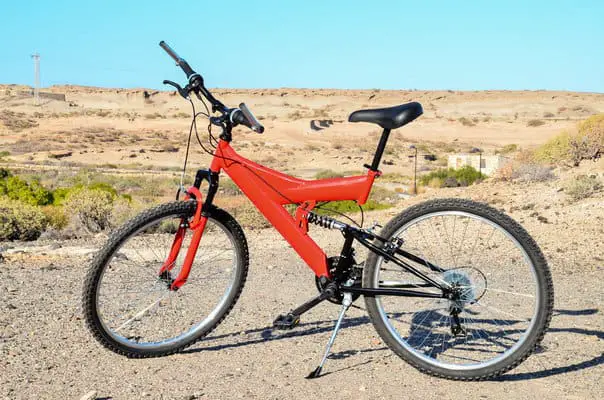Hardtail vs. softtail (full suspension) is a long-running debate in MTB performance dynamics. With many price points and build options, a hardtail and a full-suspension mountain bike might cost the same. There are a variety of factors as to why a rider would choose one or the other. So, what makes some MTB riders choose between hardtail vs. softail?
Ordinarily, hardtails are cheaper than full-suspension bikes, but when you reach parity on price, you can choose between both. The question comes down to both value and riding style. By definition, hardtails are lighter than even the best full-suspension mountain bikes. Without a shock and rear-suspension linkage, they weigh less due to greater mechanical simplicity.
The cost saving of not having that rear shock and linkage system can be spent on other parts of the best hardtail mountain bike package, such as a better fork, lighter wheels, or a more potent drivetrain. In theory, you could buy a much lighter hardtail mountain bike with better components for the same price as a full-suspension bike with similar fork travel.
In this guide, we will explore these debates and more as we explain the benefits and disadvantages between hardtail vs. softail.
Hardtail MTB
For many, hardtail is the clear winner in this debate. But will you necessarily enjoy a hardtail? There is no question that even an entry-level full-suspension mountain bike is easier and more forgiving to ride on trails than any hardtail. You can run the largest 29 x 2.6in rear tire, but nothing is going to compensate for that fixed rear triangle on a hardtail compared to the suspension travel of a linkage-driven shock when rolling over rough terrain.
If you are concerned about the future cost of bike maintenance or live in a geography where muddy rides are the norm, any hardtail is much cheaper to own. Full-suspension bikes require shock services and linkage bearing replacements, which can rapidly add to the cost of ownership if you often ride in boggy conditions.
The hardtail is also more adaptable for riders who use their mountain bike as an all-purpose cycling vehicle. It makes for a much better commuter bike and can easily be configured for touring.
Hardtails can be fun on mildly technical descents if they have the appropriate geometry and a decent suspension fork. If you suffer from any legacy injuries, lower back, or knee/ankle issues, the reality is that a hardtail will be tough on your body.
Full-suspension bikes will not only absorb the bigger hits when you land a jump or drop-off incorrectly, saving your ankles and hips from strain, but they also mute trail buzz.
Full-Suspension (Softail) MTB
It goes without saying that mountain bikers carrying some injury tension will always be more comfortable on a full-suspension bike on any terrain. For those riders who are healthier, wish to develop their skills, and explore more demanding trails, the full-suspension mountain bike is a much safer passage to progression.
Going over the bars (OTB) is a nightmare scenario for any rider, and with hardtails, that risk is significantly heightened in steep technical terrain. Once you run out of front fork travel, there is no suspension action in the rear to defuse the balance point momentum of a potential OTB moment. Full-suspension bikes are more forgiving and less likely to buck a rider over the bars.
If you live in an area where most of the trails are smooth and flowing, the difference between a hardtail and a full-suspension bike is marginal. Riders who pedal a fair distance to get to their trailhead could be advised to opt for a hardtail, which has lower maintenance and is more efficient at converting energy to forward momentum.
Rocky and rooty trails, such as here in Albuquerque, can become a bit more of a challenge on any hardtail, however. This is where even a short-travel full-suspension bike gives much better confidence and control. While you will probably develop more ‘correct’ jumping and drop-off techniques learning on smooth skills tracks on a hardtail, for repetitive hits, a full-suspension bike is going to be kinder on your body.
If you are in great physical condition, ride throughout winter, frequent buffed trails and like to use your mountain bike as a dual-purpose commuter, a hardtail is ideal.
For those riders who live close to a trailhead or don’t mind driving to trail venues, the dual-suspension mountain bike will be comfier and faster on all grades of technical singletrack. This is especially true if you are nursing some age- or injury-induced physical conditions.
If you have a set budget and ride smooth trails in all weather conditions, totaling massive yearly mileages, get a hardtail.
Like the idea of hitting some small drops and rushing rock gardens? The dual-suspension option will be better for you, but you’ll be buying a notably heavier bike for the same money.
Hardtail bikes often have aluminum or carbon fiber frames. Aluminum is stronger, while carbon fiber is lighter. Therefore, pick the former if your bike will be subjected to rough handling.
It’s important to consider the price of the bike, as well.
A price of $2000 or more will often get you a high-quality product that’s both lightweight and good for racing. A lower cost (under a grand) should suffice for regular exercises and commutes.
Although it’s possible to save money when purchasing bikes, being too frugal (buying a $300 bike, for example) might cost you more in repairs in the long run.
Another thing to consider is the length of the fork legs. These parts usually measure from 100mm to over 180mm, with higher lengths being better for rough terrains. Think of where you will ride your bike and size your stanchions accordingly.
Finally, always consider the size of the wheels. Mid-size wheels (around 27 inches) are popular choices for beginners. Overall, bike sizes differ across brands, so look for brand-specific sizing charts and consult the sellers in person.

Suspension Explained
Bikers would often wonder why suspension is an important factor. Suspension can help us differentiate hardtail mountain bike vs full suspension and help answer the question “what is a hardtail mountain bike?”
We all know that suspension is a common feature on most mountain bicycles. Essentially, this component absorbs bumps on the roads and ensures the bike remains stable.
Hardtails only have front suspension, while full-suspension bikes have both front and rear suspension. This is why on rough terrains, riders will have to exert more effort when using a hardtail. If you’re not very athletic, which type you choose makes a huge difference.
Full-suspension mtb is the rational option for maximum performance in gravity-fed activities. I always emphasize this one because I don’t want you to regret your choice, especially if it doesn’t fit your riding style.
Riding Dynamics Compared
The Merida One-Twenty, like many other entry-level dual suspension bikes, is aimed at the trail rider and features slightly increased suspension travel (120mm front and rear) and a relaxed rider position in order to boost control and comfort on technical terrain. Compare that with the hardtail: the position is more forward and aggressive, with a shorter 100mm travel fork on the front to keep the handlebar height a little lower for climbing.
With this, riders looking to hit the trails with their more experienced riding mates will probably have the most fun on the full suspension. Those seeking a more efficient climber or a bike to do some competitive cross-country racing will be suited to a hardtail.
It’s also worth mentioning that hardtails teach you how to ride properly, using your body to absorb shock and not relying on the bike; so if your ambitions are to become a skillful rider, the hardtail may be your best starting point – though you can expect a steeper learning curve.
Ride style and ambition summary: This is the most personal aspect of the battle and the result depends on you. Want to refine your skills and ride fast on cross country trails? Go the hardtail. Want to ride technical terrain and just keep up with your more experienced mates? Go the full suspension.
Climbing
If your rides consist of long, testing climbs, then the low weight and rigid rear end of the hardtail is going to lead to the least amount of wasted energy. Here, it’s common to see XC racers go with a hardtail for its ability to stand out of the saddle and pedal without energy lost into the suspension. Sure, full suspension setups have lockouts, but you need to remove to use them – and even then they’re never as rock-solid as a hardtail.
When climbs get rough or technical though, then the full suspension starts to fight back as the suspension helps to keep the rear tire in contact with the ground and allows you to keep cranking with less interruption. Sure, the extra weight will be felt, but sometimes traction is more important.
Another factor to consider is geometry – the more relaxed ‘trail’ position of the full suspension tends to wander on steep climbs and requires a little more muscle to point it where desired. The hardtail is a more thoroughbred climber, in that its aggressive position stays pointed to the sky and screams for you to go faster.
Climbing summary: Smooth and/or extended climbs have the low weight and energy-efficient hardtail storming ahead. As trails get rougher and more technical, the additional traction afforded by the full suspension hits back. But the overall weight and more relaxed position isn’t enough to overcome the hardtail’s ascending poise.
Descending
Finish that climb and hit the descent… now the full suspension is rolling into the lead. That relaxed position and bouncy rear end hurting on the climbs is now a huge positive. The full suspension bike offers a more rearward-biased position that promotes confidence going downhill, especially when it’s steep.
A longer wheelbase also helps to keep the full suspension balanced and controlled at high speed, while the hardtail can start to feel skittish.
Final Thoughts

Knowing the difference between a hardtail vs full suspension mountain bike allows you to assess which type works better for your next trip.
This way, you can stay comfortable throughout the ride and never worry about finding a suitable bicycle for your trips.
We’ve looked at the component specifications and weights, but what really matters is how the bikes perform on the trail. Before we go comparing exact trail situations, it’s important to look at your ride style and ambition. Despite being at the same price point, it’s clear these bikes aren’t necessarily aimed at the same rider.
